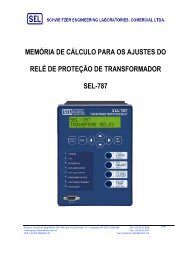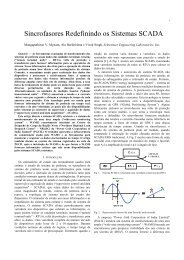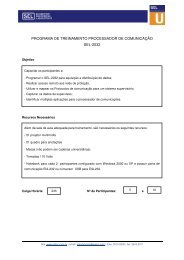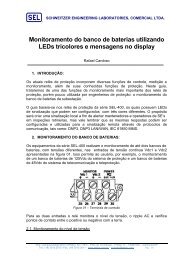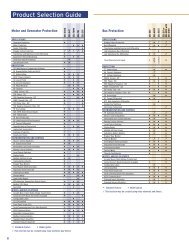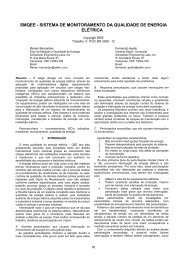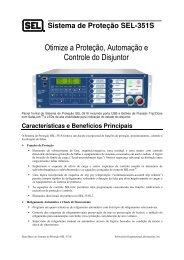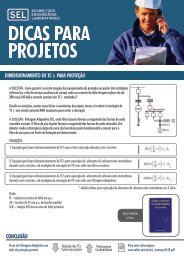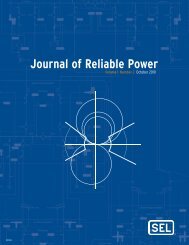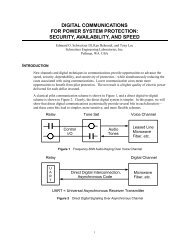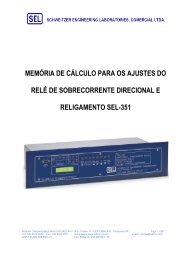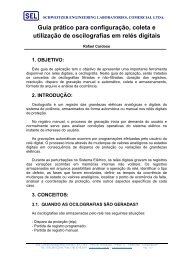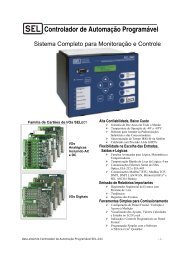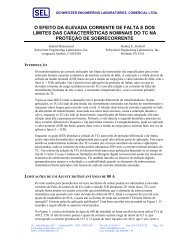Journal of Reliable Power - SEL
Journal of Reliable Power - SEL
Journal of Reliable Power - SEL
You also want an ePaper? Increase the reach of your titles
YUMPU automatically turns print PDFs into web optimized ePapers that Google loves.
5<br />
MTCS<br />
Z3RB<br />
67N3<br />
67Q3<br />
Z3G<br />
M3P<br />
3P0<br />
OR 1<br />
AND 2<br />
0<br />
Z3RBD<br />
(Setting)<br />
AND 5<br />
OR 4<br />
Key<br />
EBLKD = OFF<br />
(Setting)<br />
ETDPU = OFF<br />
(Setting)<br />
PT<br />
(Input)<br />
AND 1<br />
0<br />
EBLKD<br />
(Setting)<br />
AND 3<br />
(Setting)<br />
ETDPU<br />
0<br />
0<br />
EDURD<br />
(Setting)<br />
AND 6<br />
EKey<br />
Fig. 13.<br />
Partial Relay POTT Scheme Logic Diagram<br />
Terminal 1 correctly sees the fault as reverse according to<br />
its directional element (1_32q). The PTT signal sent by<br />
Terminal 2 is received 10 ms later by Terminal 1 (1_OUT2).<br />
OUT2 is programmed to follow the local PT logic bit (PTT<br />
received).<br />
A portion <strong>of</strong> the relay POTT scheme logic diagram is<br />
shown in Fig. 13. The relays include logic that permits rapid<br />
clearing <strong>of</strong> end-<strong>of</strong>-line faults when one line terminal is open or<br />
has a very weak source. This is referred to as “echo” logic [5].<br />
The open breaker or weak source terminal is allowed to echo<br />
the received permission signal as long as two main conditions<br />
are met:<br />
1. A reverse fault must not have been detected by the<br />
reverse-looking elements (67N3, 67Q3, Z3G, M3P).<br />
2. The PTT input must be received for a settable length <strong>of</strong><br />
time.<br />
At Terminal 1, no reverse-looking elements are asserted.<br />
After 2 cycles, Terminal 1 echos the received PTT signal back<br />
to Terminal 2 as a four-cycle pulse. Why did Terminal 1 not<br />
have a reverse-looking element asserted The Zone 3 reverse<br />
ground distance element (Z3G) was desensitized by infeed<br />
from other lines at the utility bus. Reverse ground overcurrent<br />
(67N3) was not enabled at this relay.<br />
Meanwhile, the fault is still visible and on the system, and<br />
3 cycles after Terminal 2 originally sent PTT, it receives its<br />
own echoed signal back. This is received by Terminal 2 as<br />
PTT, and a local high-speed trip is asserted (2_OUT1&2).<br />
In Fig. 11, note the fault between Breakers 5 and 6; the<br />
67N2 ground overcurrent element at Breaker 3 is sensitive<br />
enough to see this fault, and Breaker 3 sends a PTT signal to<br />
the relay at Breaker 4. At Breaker 4, no reverse 67N3 ground<br />
overcurrent element is enabled. The ground distance element,<br />
Z3G, at Breaker 4 is not sensitive enough to see this reverse<br />
fault, so the Breaker 4 echo logic returns the received PTT<br />
signal. The result is that Breaker 3 trips for an out-<strong>of</strong>-section<br />
fault. The parallel line tripped in identical fashion.<br />
The root cause <strong>of</strong> this misoperation was dissimilar<br />
sensitivities in the local and remote relays. This difference was<br />
not because <strong>of</strong> differences in design, make, or model. The<br />
difference was because <strong>of</strong> different settings and elements<br />
enabled at each end <strong>of</strong> the line by different engineers. This<br />
was not discovered in the engineering review or by<br />
commissioning tests.<br />
Engineers and technicians continue to perform detailed<br />
element tests during commissioning. Testing the overall<br />
protection system, including installed settings, is more<br />
important. End-to-end testing in the lab before installation or<br />
end-to-end satellite-synchronized testing during commissioning<br />
may have found this setting problem. In order to do so, the<br />
test voltages and currents for each line terminal would have to<br />
be provided from a model <strong>of</strong> the power system for faults at the<br />
end <strong>of</strong> element reaches.<br />
When installing a POTT scheme, the need for echo logic<br />
should be considered carefully. Do you even have the<br />
possibility <strong>of</strong> a weak infeed condition If you enable echo<br />
logic, it is critical that reverse-looking Zone 3 elements are<br />
enabled so that they can supervise the echo decision. Local<br />
and remote line relay sensitivities should be coordinated, i.e.,<br />
if ground overcurrent elements are enabled at the local end<br />
(forward 67N2, reverse 67N3), they should be enabled at the<br />
remote end as well [6].<br />
In this event, we also notice that once an echo key<br />
condition was established, it continued indefinitely until<br />
stopped by personnel intervention. In Fig. 13, if echo pulse<br />
duration EDURD is set longer than pickup ETDPU, the local<br />
and remote relays will establish a permanent echo key<br />
condition. To prevent this from occurring, set ETDPU to 2<br />
cycles and EDURD to 1 cycle. Limiting the echo duration to<br />
less than the echo time-delay pickup ensures that a permanent<br />
echo key condition will not occur. A one-cycle duration is<br />
more than adequate for recognition by modern relays. The<br />
traditional criteria that the echo signal be longer than the<br />
remote breaker tripping time is not required if relays include<br />
an appropriate minimum trip duration time. The echo signal<br />
only needs to be long enough to initiate the high-speed trip,<br />
after which the trip duration delay determines how long a local<br />
trip signal is maintained to the breaker. A typical trip duration<br />
setting is 9 cycles.<br />
56 | <strong>Journal</strong> <strong>of</strong> <strong>Reliable</strong> <strong>Power</strong>



